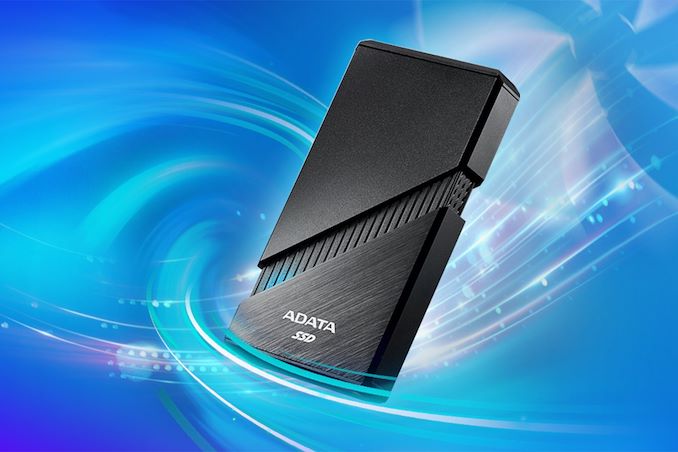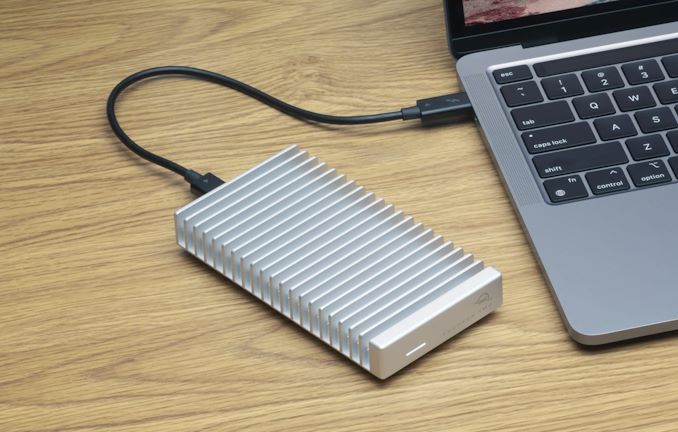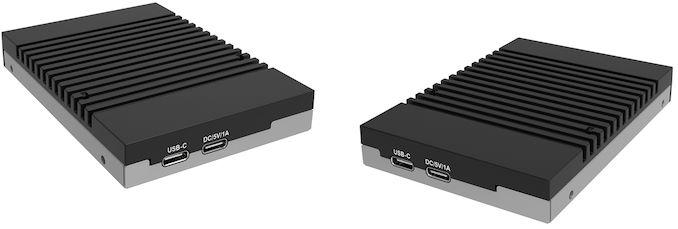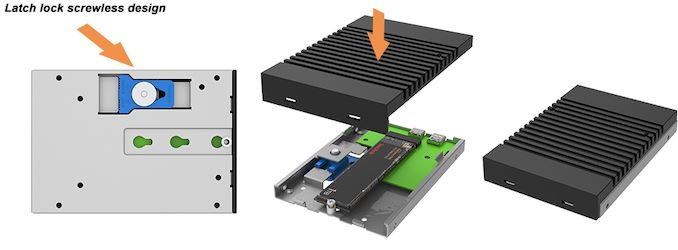Adata, OWC, and Stardom Roll Out USB4 SSDs and Enclosures for Faster External Storage
by Anton Shilov on December 13, 2023 11:00 AM EST- Posted in
- Storage
- SSDs
- ADATA
- Thunderbolt
- OWC
- External SSDs
- USB4
- Stardom

When the USB4 specification emerged several years ago, it was quickly positioned as a less expensive alternative to the Thunderbolt 3 technology which ruled the market of high-performance direct-attached storage (DAS) devices and docking stations. Since then, we've seen multiple USB4 docks hit the market, but USB4 DASes and SSDs are still rare. Thankfully, the situation began to change in the recent weeks, as multiple vendors have finally begun releasing their own USB4 SSDs and external drive enclosures.
Adata
Adata announced its first SE920 External USB4 SSD back in August 2021, but it only started shipping these drives in October. Adata's SE920 External SSDs offer capacities of 1 TB or 2 TB, along with a sequential read speed rating of up to 3.8 GB/s as well as a sequential write speed of up to 3.7 GB/s when working with a USB4 host. Otherwise, the drive is rated for 3.20 GB/s on Thunderbolt hosts, due to the greater overhead of the Thunderbolt protocol.
One interesting feature of the Adata SE920 External USB4 SSD is that it comes with a 'telescoping' case that allows to activate its internal fan for better heat dissipation. Such design allows to better ensure consistent performance under high loads, which is set to be particularly useful when transferring large volumes of data. Meanwhile, like other modern SSDs, the SE920 uses pseudo-SLC caching, which means that it demonstrates its maximum performance only while there is spare SLC-cache.
Adata's drive looks like a very decent product overall, and it's priced very competitively with other high-performance drives on the market, with Adata charging around $150 for the 1 TB version and $200 for the 2 TB version.
OWC
Meanwhile, for the DIY crowd that wants to build their own USB4 SSDs, standalone USB4 enclosures are finally available as well. OWC's Express 1M2 enclosure is based on the ASMedia ASM2464PD USB4/Thunderbolt to NVMe bridge, and is compatible with virtually any NVMe M.2-2280 SSD.
The enclosure supports sequential read/write speeds of up to 3,151 MB/s, as well as capacities up to 8 TB (the largest M.2 2280 drive capacity currently available). Mindful of how warm modern, high-end SSDs can get, the enclosure's case acts like a huge heat sink, helping to keep those increasingly toasty SSDs cool.
On paper, OWC's Express 1M2 DIY enclosure does not reach speeds quite as high as Adata's SE920 SSD, so the extra capacity and ability to throw in any M.2 SSD you have lying around are the main selling points of the device. Pricing, on the other hand is a higher hurdle; OWC is charging $119.99 for the Express 1M2 enclosure on its own, and $219.99 for the enclosure with pre-installed 1 TB SSD.
Stardom
Although OWC's DIY USB4 SSD enclosure seems a bit overpriced, good news is that the company is not alone selling such devices. Stardom also has its UBOX-B4BP USB4 SSD enclosure that has the same feature set (e.g., compatibility with almost any M.2-2280 SSD and latest PCs), but it is slightly larger and its rated performance figures are up to 2,920 MB/s for writes and up to 3,214 MB/s for reads.
The enclosure allows building external USB4 storage solutions of up to 8 TB (and larger when such drives become available) that can work with both new and old PCs. Interestingly, Stardom has included a second USB-C connector on the enclosure solely for power purposes, allowing it to be used with an external power adapter if a host can't provide enough bus power on its own.
Stardom yet has to start selling its its UBOX-B4BP USB4 SSD enclosure in the U.S. and Europe, but in Taiwan the product costs NT$3,990 ($120 without VAT), which is not exactly cheap.














22 Comments
View All Comments
abufrejoval - Monday, January 8, 2024 - link
You can blame it on the PDP-11/34 with its dual swappable 10MB 19” (DL-10?) rack sized single platter disk drives, or you can blame it on the dual floppy Apple ][ that I saved for working on the PDP-11, but as a consequence of those juvenile impressions I’ve always yearned for the ease of swappable primary storage and the speed of non-volatile RAM (the PDP-11 had magnetic core memory).Yeah, it’s nice that swappable storage today has moved ever so slightly beyond SATA speeds, but the loss of flexibility (moving media between internal, external or hot-swap-internal use) vs. SATA hasn’t really paid in significantly better performance: NVMe has moved forward quite a bit, is at 15/12GByte/s now, according to Sabrent, somewhat less on my systems, none of which go beyond PCIe v4 yet.
But it’s certainly no longer 1GByte/s, which is more or less what I’ve been able to get, even on TB, as none of the enclosures I got used more than 2 PCIe 3.0 lanes, an important detail none of them ever mentioned in their specs.
With µ-SDcard media at 2TB and USB4 or TBx based media of the same capacity being easily 100x the volume robbing desk space and occupying valuable ports with cables that are both in the way and far too easy to suffer accidental unplugging or tearing, I wonder if somehow engineering (hello, anyone left?) got the message that consumers would really like storage that can be plugged INTO a chassis in any of the common form factors from ultrabook via NUC to workstation tower while offering speedy primary/bootable but also hot-swap storage that will remain compatible for a decade or two and doesn’t cost a kidney.
I had PDP-type bootable Syquest 5 ¼” swappable hard disks with a different OS on each at 40 or 80MB when hard disks were typically 5 ¼” full height (the space that today easily accommodates 8 2.5” hot-swap SATA media) and I had Limdow MO drives that looked just like a 3.5” floppy after some Christmas fattening but stored nearly 500x as much data: Those were the first MO type you could actually boot without growing a beard, but mostly they promised near eternal durability (turns out storage capacity is the real killer).
By today’s standards they were giant, tower chassis-only, but just like floppies, DVD-drives or µ-SDcards they ‘swallowed’ their media, enclosing and protecting the most precious of your digital possessions, data, with all their physical might, while they’d release it safely (mostly) on your command.
I’m rather sure that this is what many consumers desire and few would mind if it came included anyway. Yet, I see that perpetually staying out of reach, even if the technical assets that would make it possible remain tantalizingly within reach.
One reason is certainly corporate politics, which has always tried to keep a maximum of control over the storage that is supposed to be yours on a Personal Computer. For ages, Windows NT resisted running from media it recognized as potentially portable and Apple’s unspeakable perversion of personal storage tied to a chip they solder is the ugliest outgrowth of that mindset.
A lot may also be technical: running high-bandwidth data has always meant the shortest possible connections and the fewest yet most reliable connectors
But most of it seems to be engineers trying to gain more control over consumers via the devices they sell than creating empowerment for consumers: if they stop to think about it, they’d probably argue that management sets those goal posts. But every now and then technology that truly empowers creates a new market…
µ-SD cards are great, until they fall into one crack or another or you rolled your chair over the one with the truly precious data. But at 2TB per unit today, the only thing I’m missing are enclosures and controllers to RAID them together if capacity and speed are holding them down. To me they present the primarily-portable storage device form factor.
With compact flash (just the size, not the connector or interface) I felt removable media enjoyed an extremely reasonable form factor: small enough to fit even into an ultra-book or tablet device, yet with sufficient room and surface to contain and cool potentially very active components inside. They are also much easier to “manage on a crowded desk” and won’t fall as easily into the smallest cracks (or even between the keys of a proper keyboard). I’d see something like them as the primarily-powerful storage device form factor.
For all I care they could be Flash, or in fact CXL [NV-]RAM, but ‘stackability’ or RAIDability again ensures that they don’t get invalidated by technical progress before their standardization got through the committees.
And for these form factors I would want flexibility in terms of just how removable or exposed these two major media types might be: having them stick out for dock usage could be fine, as could be a spring-loaded or lever based or in fact motorized ejection mechanism. Outside sealing covers for “Toughbooks” or embedded sounds like the ticket, on a notebook I dislike anything that sticks out, because accidents, co-workers and kids to happen.
Today, whenever I plug one of these USB connected storage devices, I find myself far too often flying into fits of frustration, because the stick and the port won’t match form factor (USB-A/USB-C) or won’t fit side-by-side into the same notebook, or the proper adapter or cable just happens to be used elsewhere, just isn’t not around, or in fact turns out to be defective after far too little use.
What tends to calm me these days is that no AI I’ve tried has even remotely suggested such a product could be a “market disruptor”, because the best they can do is mimic average intelligence which is a far cry from human ingenuity… whose underlying driver is often frustration they cannot feel.
So, if there are some warm-blooded engineers left out there: could you please re-invent practical empowering personal computing storage based on usability, please?
roddaman - Monday, February 19, 2024 - link
Why is no company making enclosures for high capacity (22TB) 3.5 in. hard disk drives? Are the benefits of such enclosures moot because they cannot really make use of 40 Gbps speeds like SSDs can?